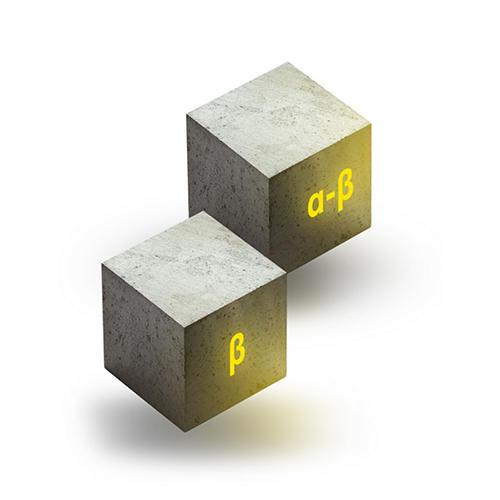Casings
Typical Components:
Turbine Casing, Intermediate Casing, Combustion Casing, Fan Casing
Material:
Ti6Al4V, Stainless Steels, Inconel 718
Titanium alloys retain strength at high temperatures and exhibit low thermal conductivity.
Stainless Steels have a chromium content of at least 12%. It is very reactive from a chemical point of view and is prone to oxidization. The oxide generates a fine, protective skin.
Inconel is a superalloy characterized by a unique combination of high temperature corrosion resistance, oxidation resistance, and creep resistance.
Alpha-Beta (α-ß) Alloys
These alloys feature both αand ß phase and contain both α and ß stabilizers.
The simplest and most popular alloy in this group is Ti6Al4V, which is primarily used in the aerospace industry. Alloys in this category are easily formable and exhibit high room-temperature strength and moderate high-temperature strength. The properties of these alloys can be altered through heat treatment.
Beta (ß) Alloys
Beta (ß) alloys contain transition metals, such as V, Nb, Ta, and Mo, that stabilize the ß-phase. Examples of commercial ß alloys include Ti11.5Mo6Zr4.5Sn, Ti15V3Cr3Al3Sn, and Ti5553. Beta alloys are readily heat-treatable, generally weldable, and have high strength. Excellent formability can be expected in the solution treated condition. However, ß alloys are prone to ductile-brittle transition and thus are unsuitable for cryogenic applications. Beta alloys have a good combination or properties for sheet, heavy sections, fasteners, and spring applications.

Nickel Base Alloys
Among the high-temperature alloys, nickel-base alloys are the most widely used. As a result, they are often found in aerospace engine and power generation turbine components, as well as in petrochemical, food processing, nuclear reactor, and pollution control equipment. Nickel-base alloys can be strengthened by two methods: through solid solution strengthening or by being hardened through intermetallic compound precipitation in fcc matrix. Alloys such as INCONEL® 625 and Hastelloy® X are solid solution strengthened. These solid solution hardened alloys may get additional strengthening from carbide precipitation. Alloys such as INCONEL® 718, however, are precipitation strengthened. A third class of nickel-base superalloys, typified by MA-754, is strengthened by dispersion of inert particles such as yttria (Y2O3), and in some cases with γ´ (gamma prime) precipitation (MA-6000E). Nickel-base alloys are available in both cast and wrought forms. Highly alloyed compositions, such as Rene 95, Udimet 720, and IN100, are produced by powder metallurgy followed by forging. For the above wrought alloys and for cast alloys (Rene 80 and Mar-M247), the strengthening agent is γ’ precipitate. For INCONEL® 718, γ˝ (gamma double prime) is the primary strengthening agent. Alloys that contain niobium, titanium, and aluminum, such as INCONEL 725, are strengthened by both γ´ and γ˝ precipitates.
Iron-Nickel Base Alloys
Iron-nickel-base superalloys are similar to wrought austenitic stainless steels, except for the addition of γ´ strengthening agent. They have the lowest elevated temperature strength among the three groups of superalloys, and are generally used in the wrought condition in gas turbine disks and blades. Most wrought alloys contain high levels of chromium, which provide corrosion resistance. They owe their high-temperature strength to solid solution hardening (hardening produced by solute atoms dissolved in the alloy matrix) or precipitation hardening (hardening produced by precipitate particles). Alloys such as Haynes 556 and 19-9 DL are solid solution strengthened with molybdenum, tungsten, titanium, and niobium. Alloys such as A286 and Incoloy 909 are precipitation hardened. The most common precipitates are γ´, (Ni3 [Al, Ti]) (e.g., A286), and γ˝, (Ni3Nb) (e.g., Incoloy 909). Another group of iron-nickel-base alloys contains high carbon content and is strengthened by carbides, nitrides, and solid solution strengthening. A group of alloys, based on Fe-Ni-Co and strengthened by γ’, combines high strength with a low thermal expansion coefficient (e.g., Incoloy 903, 907, and 909) and finds application in shafts, rings, and casings for gas turbines.
The complex shape of an engine casing requires many different machining applications.
A time consuming process that involves turning, rough milling, finish milling, drilling applications like counterboring, tapping, and reaming.
Hours spent along the process chain demand reliable precision tooling.
Shoulder Milling
Grooving and Cut-Off
Please select a file to download
Models
. Please enter the desired qty for the material(s) you want to include in your promotion or Proceed Without Promotion and only your base materials will be added to the cart.
Minimum quantity should be
| SAP Material Number | ISO Catalog Number | Grade |
|---|
You are about to leave the Solution building process.
Are you sure you want to leave?